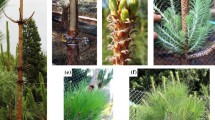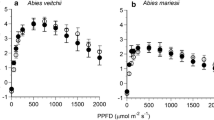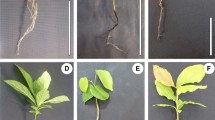Abstract
The higher growth rates of resprouting shoots compared with those of mature plants in resprouter woody species are supported by higher rates of photosynthesis and transpiration. In this contribution we hypothesize that species with higher resprouting vigour will show a larger enhancement of photosynthesis in resprouting shoots. We test this hypothesis by comparing gas exchange and leaf parameters between resprouting and mature plants in Erica scoparia and E. australis. These two Erica species co-occur in Mediterranean heathlands of the Strait of Gibraltar. Erica scoparia has a higher rate of post-disturbance starch recovery than E. australis, which makes it more resistant to recurrent disturbance. We tested the hypothesis that enhancement of photosynthesis and water use characteristics of resprouting shoots compared with mature plants should be more pronounced in E. scoparia. In both species, resprouts had higher efficiency in the use of light and higher maximum net photosynthesis than mature shoots. However, contrary to expectations, differences in the photosynthetic performance between resprouts and mature plant shoots were larger in E. australis. Higher root to shoot ratios in resprouting E. australis plants, determined by their slower above-ground recovery, together with stronger demand from carbon sinks might explain this result.




Similar content being viewed by others
References
Bayer E (1996) Síntesis genérica de Erica. In: Castroviejo S, Aedo C, Gómez CC, Laínz M, Montserrat P, Morales R, Muñóz GF, Nieto FG, Rico E, Talavera S, Villar L (eds) Flora Ibérica. Plantas vasculares de la península Ibérica e islas Baleares. Real Jardín Botánico, Consejo Superior de Investigaciones Científicas, Madrid, pp 485–506
Bell TL, Pate JS (1996) Growth and fire response of selected epacridaceae of south-western Australia. Aust J Bot 44:509–526
Bond BJ (2000) Age-related changes in photosynthesis of woody plants. Trends Plant Sci 5:349–353
Bond WJ, Midgley JJ (2001) Ecology of sprouting in woody plants: the persistence niche. Trends Ecol Evol 16:45–51
Bowen BJ, Pate JS (1993) The significance of root starch in postfire shoot recovery of the resprouter Stirlingia latifolia R. Br. (Proteaceae). Ann Bot 72:7–16
Buckley TN (2005) The control of stomata by water balance. New Phytol 168:275–292
Canadell J, López-Soria L (1998) Lignotuber reserves support regrowth following clipping of two mediterranean shrubs. Funct Ecol 12:31–38
Castell C, Terradas J, Tenhunen JD (1994) Water relations, gas exchange, and growth of resprouts and mature plant shoots of Arbutus unedo L. and Quercus ilex L. Oecologia 98:201–211
Chalker BE (1980) Modeling light saturation curves for photosynthesis: an exponential function. J Theor Biol 84:205–215
Davis SD, Mooney HA (1986) Water use patterns of four co-occurring chaparral shrubs. Oecologia 70:172–177
DeSouza J, Silka PA, Davis SD (1986) Comparative physiology of burned and unburned Rhus laurina after chaparral wildfire. Oecologia 71:63–68
Fleck I, Hogan KP, Llorens L, Abadía A, Aranda X (1998) Photosynthesis and photoprotection in Quercus ilex resprouts after fire. Tree Physiol 18:607
Iwasa Y, Kubo T (1997) Optimal size of storage for recovery after unpredictable disturbances. Evol Ecol 11:41–65
Keeley JE (1986) Resilience of mediterranean shrub communities to fires. In: Dell B, Hopkins AMJ, Lamont BB (eds) Resilience in Mediterranean-type ecosystems. Dr. W. Junk, Dordrecht, pp 95–112
Koch KE (1996) Carbohydrate-modulated gene expression in plants. Ann Rev Plant Biol 47:509–540
Koricheva J (2002) Meta-analysis of sources of variation in fitness costs of plant antiherbivore defenses. Ecology 83:176–190
Kozlowski TT (1992) Carbohydrate sources and sinks in woody-plants. Bot Rev 58:107–222
Kruger EL, Reich PB (1993) Coppicing affects growth, root: shoot relations and ecophysiology of potted Quercus rubra seedlings. Physiol Plant 89:751–760
McCullagh P, Nelder JA (1989) Generalized linear models. Chapman and Hall, London
Niinemets Ü (2010) Responses of forest trees to single and multiple environmental stresses from seedlings to mature plants: past stress history, stress interactions, tolerance and acclimation. For Ecol Manag 260:1623–1639
Noble JC (2001) Lignotubers and meristem dependence in mallee (Eucalyptus spp.) coppicing after fire. Aust J Bot 49:31–41
Ojeda F, Marañón T, Arroyo J (1996) Postfire regeneration of a mediterranean heathland in southern Spain. Int J Wildl Fire 6:191–198
Ojeda F, Arroyo J, Marañón T (2000) Ecological distribution of four co-occurring Mediterranean heath species. Ecography 23:148–159
Ojeda F, Pausas JG, Verdú M (2010) Soil shapes community structure through fire. Oecologia 163:1–7
Parkhurst DF (1994) Diffusion of CO2 and other gases inside leaves. New Phytol 126:449–479
Pate JS, Froend RH, Bowen BJ, Hansen A, Kuo J (1990) Seedling growth and storage characteristics of seeder and resprouter species of Mediterranean-type ecosystems of SW. Australia. Ann Bot 65:585–601
Paula S (2004) Análisis funcional de la capacidad de regeneración de tres especies de brezos rebrotadores (Erica australis, E. scoparia y E. arborea) tras perturbaciones recurrentes. Departamento de Biología. Universidad de Cádiz, Puerto Real, p 218
Paula S, Ojeda F (2006) Resistance of three co-occurring resprouter Erica species to highly frequent disturbance. Plant Ecol 183:329–336
Paula S, Ojeda F (2009) Belowground starch consumption after recurrent severe disturbance in three resprouter species of the genus Erica. Botany 87:253–259
Paula S, Ojeda F (2011) Response to recurrent disturbance of two co-occurring, resprouter heath species: the cost of withstanding herbivores. Plant Ecol. doi:10.1007/s11258-011-9927-x (special issue of Plant Ecology—Sprouting Ecology)
Ramos G, Frutos P, Fernández GM, Lavín P, Mantecón AR (1999) Valor nutritivo de especies arbustivas de puertos de montaña: efecto del contenido en taninos condensados. XXXI Jornadas de Estudio AIDA (VIII Jornadas sobre Producción Animal) ITEA. Asociación Interprofesional para el Desarrollo Agrario (AIDA), Zaragoza, pp 529–531
Reich PB, Ellsworth DS, Walters MB, Vose JM, Gresham C, Volin JC, Bowman WD (1999) Generality of leaf trait relationships: a test across six biomes. Ecology 80:1955–1969
Strauss SY, Rudgers JA, Lau JA, Irwin RE (2002) Direct and ecological costs of resistance to herbivory. Trends Ecol Evol 17:278–285
Thomas SC, Winner WE (2002) Photosynthetic differences between saplings and adult trees: an integration of field results by meta-analysis. Tree Physiol 22:117–127
Utsumi Y, Bobich EG, Ewers FW (2010) Photosynthetic, hydraulic and biomechanical responses of Juglans californica shoots to wildfire. Oecologia 164:331–338
Wildy DT, Pate JS (2002) Quantifying above- and below-ground growth responses of the western Australian oil mallee, Eucalyptus kochii subsp. plenissima, to contrasting decapitation regimes. Ann Bot 90:185–197
Wildy DT, Pate JS, Sefcik LT (2004) Water-use efficiency of a mallee eucalypt growing naturally and in short-rotation coppice cultivation. Plant Soil 262:111–128
Wright IJ, Cannon K (2001) Relationships between leaf lifespan and structural defences in a low-nutrient, sclerophyll flora. Funct Ecol 15:351–359
Zedler PH, Gautier CR, McMaster GS (1983) Vegetation change in response to extreme events—the effect of a short interval between fires in California chaparral and coastal scrub. Ecology 64:809–818
Acknowledgments
The authors thank Marco Antonio Tena, former director of Los Alcornocales Natural Park, for kindly providing facilities for field work; Mike Scott, Mike Lawes and two anonymous reviewers for assisting with the English grammar and also providing useful comments on the manuscript. This study was funded by research projects BOS2002-00609 and AGL2005-07440-C02-02/FOR from the Spanish Ministerio de Educación y Ciencia.
Author information
Authors and Affiliations
Corresponding author
Rights and permissions
About this article
Cite this article
Goorman, R., Bartual, A., Paula, S. et al. Enhancement of photosynthesis in post-disturbance resprouts of two co-occurring Mediterranean Erica species. Plant Ecol 212, 2023–2033 (2011). https://doi.org/10.1007/s11258-011-9967-2
Received:
Accepted:
Published:
Issue Date:
DOI: https://doi.org/10.1007/s11258-011-9967-2




